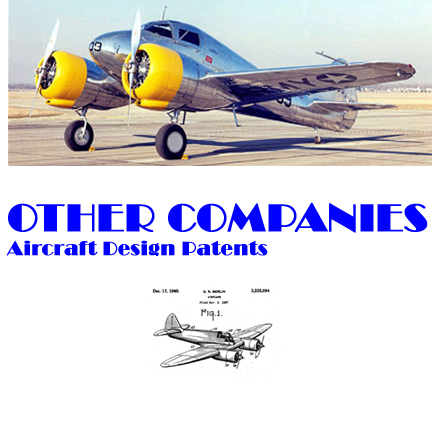
Other Manufacturers of Aircraft
Other Aircraft Design Patents

Join Us on Facebook
Miscellaneous Aircraft Design Patents

Our treatment of aircraft began as an account of my trials and tribulations in building a 1948 airplane model kit. Since then, we have developed a wealth of patent diagrams for historic aircraft, so many in fact that the page was quite slow in loading. On November 25, 2009 we split the material into six segments, corresponding to the six boxes or "buttons" below. If you came in from a search engine looking for something very specific, click here for the Analytical Index that will enable you to find what you want very quickly.
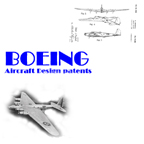
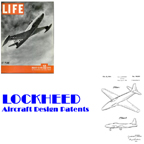
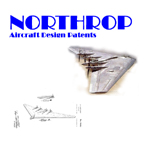
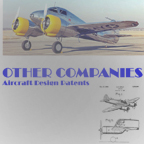
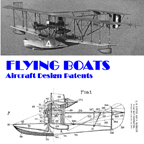
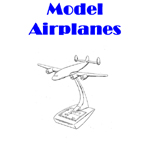
Hello! Welcome to our page about design patents for unusual aircraft. Since you may have come here with a specific purpose, here are some helpful shortcuts
Aircraft from Other Manufacturers- Curtiss-Wright CW-25 (Mil: AT-9) Jeep Two Engine Trainer
- Douglas SBD Dauntless Dive Bomber
- Curtiss SB2C Helldiver Dive Bomber
- Republic P-43 Lancer Fighter
- Republic P-47 Thunderbolt Fighter
- Vultee A-31 Vengeance Dive Bomber
- Vultee XP-54 Swoose Goose Fighter
- Republic A-31 Thunderjet Fighter
- Fairchild C-82 Packet Cargo-Transport
- WACO Aristocraft Executive Transport
- North American F-100 Super Sabre Fighter
This is part of a general Retro Lifestyle/Swing Dancing website. We have a Guide to 1940s Treasures and a Swing Dance Calendar for Washington DC.. Please feel free to Contact Us if you'd like to comment on the golden age of balsa wood models.
Other Aircraft
This is sort of a "catchall" category for planes and manufacturers for which we have only a few patent diagrams. This is not to say that these are "minor" firms -- the Curtiss company gave the US JN-4 "Jenny" of World War I and the P-40 Warhawk that performed so well with the Flying Tigers in China.
Curtiss-Wright CW-25 (Mil: AT-9) "Jeep" Two Engine Trainer
In 1940, with Europe already at war, the US Army Air Corps knew that it would need to train pilots for multi-engine flight. The Army evaluated the Cessna T-50 as an 'off-the-shelf' twin-engined trainer to manage the transition of a pilot qualified on single-engined aircraft to a twin-engined aircraft and their very different handling technique. Procured as the AT-8, Cessna's T-50 was built in large numbers.
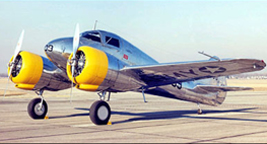
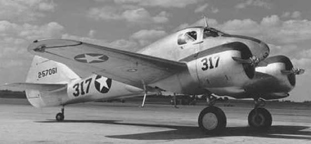
Curtiss-Wright CW-25 "Jeep"
Click to Enlarge
For the more specific transition to a "high-performance" twin-engine bomber it a plane more advanced than the T-50 was needed. Curtiss-Wright met this need with the CW-25 that had the take-off and landing characteristics of a light bomber aircraft.
The type was produced as the AT-9 "Jeep". A total of 491 AT-9s was produced and these were followed into service by 300 generally similar AT-9A aircraft.
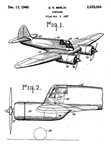
Patent Diagram for the Curtiss-Wright CW-25 "Jeep"
Patent No. 2,225,094
Click to Enlarge
Click Here to learn how to get free patent diagrams
Of note, Comedian George Gobel flew the AT-9 as a flight instructor at Altus, Oklahoma, during World War II.Click Here for more information about the Curtiss-Wright CW-25 "Jeep" .
Douglas SBD "Dauntless" Dive Bomber
The prototype for the SBD was developed by Northrop. The Douglas Corporation won the production contract, and began manufacturing the plane in 1940. Ed Heinemann (see Design patent below) designed the plane and led it through several versions.
The SBD, was primarily produced at the Douglas plant at Tulsa, Oklahoma. Over 2,400 were built. In addition to American service, the SBD saw combat against the Japanese with No. 25 Squadron of the Royal New Zealand Air Force,and against the Germans with the Free French Air Force.
Former President George H.W. Bush flew a Dauntless SBD in the South Pacific.
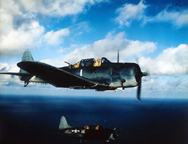
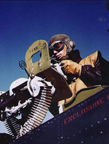
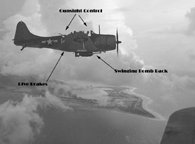
Douglas SBD "Dauntless" Dive Bomber
Click to Enlarge
Dive bombers in general and the SBD in particular have a number of interesting technical features that are shown in the following patent diagrams:
Dive Brakes:If, however, the bombing plane can be placed in a vertical dive and the bombs released during travel along an earth perpendicular, no lateral motion will be imparted to the falling objects, the plane's speed merely adding to the initial velocity of fall.... present high diving speeds seriously reduce the time available for sighting a plane on a target and releasing bombs therefrom ... the control devices slow the aircraft in its dive to give the pilot ample opportunity to aim
Swinging Bomb Rack:In dive bombing, the diving angle is preferably between 70 and 90 degrees to reduce to a minimum the gravity deviation of the bomb trajectories from the direction of the dive... The bombs released at the end of the dive, being aerodynamically cleaner than the airplane, tend to fall more rapidly than the plane. In high angle dives the bomb trajectory after release is nearly parallel to the flight path of the airplane. If the trajectory begins at the undersurface of the airplane, there is danger of the bombs falling into the propeller blades and breaking them or being exploded. Accordingly, devices have been employed to move the bomb upon its release from the bomb rack to a position sufficiently displaced outwardly from the fuselage that the bomb trajectory will clear the path of the propeller even in 90° dives....
Rear Gunsight:Ever since rearwardly firing guns were placed on an aircraft forward of the stabilizing surfaces it has been not uncommon for a gunner, in the excitement of combat and while following his target in his gun sights, to accidentally shoot into the empennage of his own craft. To overcome this, devices have been developed which prevent the gunner from moving the gun so that it can be pointed at the empennage or which prevent the gun being fired whenever the structural parts of the airplane come within the field of fire. Such interrupters serve the purpose for which they are intended but from a tactical standpoint the occurrence of the blind spot re quiring mere momentary cessation of fire gives the enemy aircraft an opening to attack. Accordingly, it is the principal object of my invention to indicate to the pilot of an aircraft s when his remotely located gunner wishes to shoot in a field obstructed by a portion of his craft so that he may maneuver the craft to clear the desired field of fire.
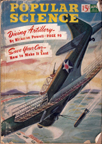

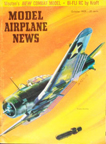
April 1942 Popular Science Article about Dive Bombing
middle: Jo Kotula, illustrator
right: October 1959 Model Airplane News cover with SBD drawn by Jo Kotula
Click to Enlarge
The April, 1942 issue of Popular Science has a very well written article about dive bombing in particular and the SBD "Dauntless" in particular. The cover (above) has a great drawing of an SBD in action, drawn by Jo Kotula, the best airplane illustrator of the period. His covers for Model Airplane News are legendary. The article may be downloaded by clicking here and it has a good discussion of dive brakes, bomb racks and sights that was written for non-technical audiences.


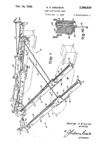

Technical Features of the SBD
Overall Design Patent D-130,473
Dive Brakes Patent No. 2,031,177
Bomb Rack Patent No. 2,386,839
Gun Position Indicator Patent No. 2,466,985
Click to Enlarge
Here is a video of a restored SBD in action.
Click here for more information about the Douglas SBD "Dauntless" Dive Bomber. Here is a very well illustrated history of one carrier pilot's experioences with the SBD during World War II.
Curtiss SB2C "Helldiver" Dive Bomber
The experimental contract for the Helldiver was awarded by the US Navy on 15 May 1939 and the prototype XSB2C-1 first flew on 18 December 1940. From that date the Helldiver two-seat carrier-borne dive bomber was the subject of constant development.
On the Cover of Model Airplane News
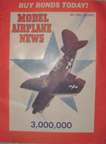
Curtiss SB2C "Helldiver"
Model Airplane News Cover for July 1944
by Jo Kotula
Click to Enlarge
Armor, self-sealing tanks, protected fuel and oil lines, increased armament, a lengthened fuselage and a completely new tail unit with greatly enlarged fixed and moveable surfaces were incorporated in the production SB2C-1 which first flew in June 1942. From that date until November 1943 (when the Helldiver first went into action in the Pacific theatre of war) more than 880 design changes were made, some of which were part of the Army-Navy standardisation programme to permit the production of an Army version of the Helldiver as the A-25, which later served with the Marine Corps.
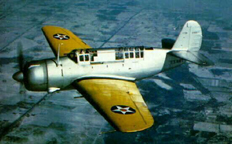
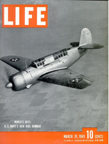
Curtiss SB2C "Helldiver"
Made the cover of LIFE Magazine (March 31, 1941 issue)
Click to Enlarge
Armament consisted of four 12.7mm machine-guns in the wings and one on a hydraulic mounting in the rear cockpit. Armament changed to two 20mm cannon. The SB2C-4 and SB2C-5, more than 3,000 of which were built, were developments of the SB2C-3 with perforated wing flaps and under-wing bomb racks under the outer wings for eight 115mm rockets.
Here is a video of a restored SB2C in action.
The SB2C was on the cover of the May 31, 1941 issue of LIFE Magazine. Click here to download a ".pdf" of the article. Click Here for more information about the SB2C "Helldiver" .
Republic P-43 "Lancer" Fighter
The Lancer (YP-43) was a 1940 single-seat interceptor fighter made by the Republic Aviation Corporation. .
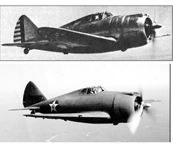
Republic P-43 "Lancer" Fighter
Click to Enlarge
The Seversky Aircraft Company, which in 1939 changed its name to Republic, constructed a range of one-off variants of its P-35 design (discussed in our section on Cleveland Model Airplane kits), featuring different powerplants and enhancements. The most significant of these was the AP-4, which served as the basis for future Seversky/Republic aircraft. It featured fully retractable landing gear, flush riveting, and, most significantly, gigantic turbo-charged engine.


Republic P-43 "Lancer" Fighter
Design Patent D-137,889
Click to Enlarge
As the P-43, 272 aircraft in three versions were produced for the USAAF, the RAAF, and China. Click Here for more information about the Republic P-43 "Lancer". However, this is not the end of the story, because the P-43 evolved into the very famous P-47 "Thunderbolt" -- discussed next.
Republic P-47 "Thunderbolt" Fighter
The "Thunderbolt" was defintely the largest single seat fighter in the war -- it was basically one gigantic engine and supercharger that had been armed to the teeth. It was one of the main United States Army Air Forces (USAAF) fighters of World War II, and also served with other Allied air forces.
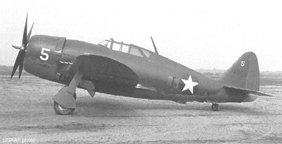



The XP-47 B
Progenitor of the P-47
Design Patent D-144,058 Click to Enlarge
But, first things first. The intermediary step between the P-43 (above) and the P-47 was a variant called the XP-47B. It had the general lines of the P-43 but due to the giant engine, it had an empty weight of 9,900 lb (65 percent more than the YP-43.) The designer, Alex Kartveli, said, "It will be a dinosaur, but it will be a dinosaur with good proportions." In fact, its proportions were excellent and it has been a subject for modeling ever since --it was on the cover of Model Airplane News twice in the space of two years:
On the Cover of Model Airplane News
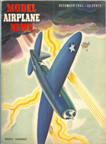
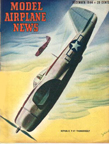
Republic P-47 "Thunderbolt"
Model Airplane News Cover for December, 1942 and December 1944
by Jo Kotula
It was very popular...
Click to Enlarge
The armament consisted of eight5o caliber machine guns, four in each wing. The XP-47B first flew in early May 1941 and demonstrated astoundding speed, range, climb and ability to dominate the skies at high altitude, qualities that were desperately needed to attain air superiority in Europe.
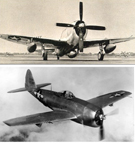
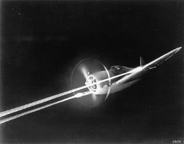
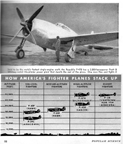
Republic P-47 "Thunderbolt"
right: article from the April 1942 issue of Popular Science
Click to Enlarge
The P-47 production version, also known as the "Jug," was the biggest, heaviest, and most expensive fighter aircraft in history to be powered by a single reciprocating engine. It was effective in air combat but proved especially adept at ground attack. It had eight .50-caliber machine guns, four per wing. When fully loaded the P-47 could weigh up to eight tons. The Thunderbolt was described in glowing terms in a 1942 article in Popular Science (right photo). Click Here to download a ".pdf" of this article.



The Republic P-47 "Thunderbolt"
Design Patent D-139,729
Click to Enlarge
Here is a video of the P-47 in action:
Click Here for more information about the Republic P-47 "Thunderbolt".
Vultee A-31 "Vengeance" Dive Bomber
The Vultee Model 72 two-seat dive bomber was designed to a British specification by Vultee and was put into production by both Vultee and Northrop. When the US entered the war, the Vengeance was given the USAAF designation A-31.
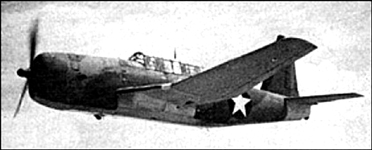
Vultee A-31 "Vengeance"
Click to Enlarge
A total of 1,500 copies of the plane were built. About 600 of the A-31 and subsequent models were supplied to Britain as Vengeance IV, a small number were delivered to the Brazilian government, and the rest went into USAAF service.
On the Cover of Model Airplane News
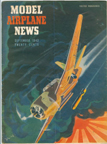
VulteeA-31 "Vengeance"
Model Airplane News Cover for September, 1943
by Jo Kotula
Click to Enlarge
The cover art above is just a bit dramatic -- the career of the A-31 was somewhat prosaic. The British only used the Vengeance in the India-Burma theatre. The USAAF A-35 were mainly used as high-speed target tugs. Production of the Vengeance ceased in the autumn of 1944.


Patent Diagrams for the Vultee A-31
Design Patent D-132,461
Click to Enlarge
Click Here to learn how to get free patent diagrams
Here is a video showing a 1/6 scale model of the "Vengeance" in action.
Click Here for more information about the Vultee A-31.
Vultee XP-54 "Swoose Goose" Fighter
Vultee submitted a proposal in response to a U.S. Army Air Corps request for an aircraft with unusual configuration. The Vultee design won the competition, beating the Curtiss XP-55 "Ascender" and the Northrop XP-56 "Black Bullet" (above).
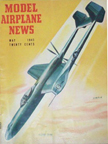
Vultee XP54 "Swoose Goose"
Model Airplane News Cover Art for May, 1945
by Jo Kotula
Click to Enlarge
Vultee had designated it Model 84, a descendant of their earlier Model 78. After completing preliminary engineering and wind tunnel tests, a contract for a prototype was awarded on 8 January 1941. A second prototype was ordered on 17 March 1942.
The Pratt & Whitney X-1800 engine was initially proposed as the powerplant but after its development was discontinued, the liquid-cooled Lycoming XH-2470 was substituted.
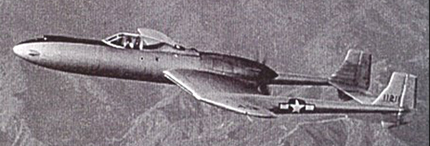
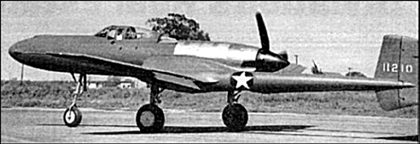
Vultee XP-54 "Swoose Goose"
Click to Enlarge
The XP-54 was designed with a pusher engine in the aft part of the fuselage. The tail was mounted rearward between two mid-wing booms, with the 12-ft propeller between them. The design included a "ducted wing section" and radiators and intercoolers in the inverted gull wing. Although it appeared to be a radical design, its actual performance was lackluster and the project was subsequently canceled.
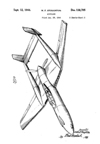

Patent Diagrams for the Swoose Goose
Design Patent D-138,795
Click to Enlarge
Click Here to learn how to get free patent diagrams
Click Here for more information about the "Swoose Goose" .
Fairchild C-82 "Packet" Cargo-Transport
Fairchild designed the F-78 to meet a 1941 Army requirement for a specialised military freighter.A contract for a single prototype was awarded and given designation XC-82. It was a cantilever high-wing all-metal monoplane. The roomy fuselage had a flight deck for a crew of five and a large-capacity cabin/cargo hold with clamshell doors at the rear to provide easy access for wheeled or tracked vehicles. It first flew in late 1944.
Fairchild C-82 "Packet" Cargo-Transport
Click to Enlarge
The rear doors could be removed completely for the deployment of heavy loads by parachute-extraction techniques, and could accommodate 78 persons for emergency evacuation, 42 fully-equipped paratroopers or 34 stretches.
Problems surfaced almost immediately as the aircraft was found to be underpowered and its airframe inadequate for the heavy lifting it was designed to perform. As a result the Air Force turned to Fairchild for a solution to the C-82's shortcomings. A redesign was quickly performed under the designation XC-82B, which would overcome all of the C-82A's initial problems. First flown in 1947, the XC-82B would go into production as the C-119B Flying Boxcar.
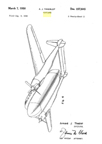
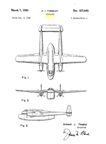
Patent Diagrams for the C-82 "Packet"
Design Patent D-157,645
Click to Enlarge
Click Here to learn how to get free patent diagrams
Click Here for more information about the Fairchild "Packet".
WACO "Aristocraft" Executive Transport
The Waco Aircraft Company (WACO) was an aircraft company located in Troy, Ohio, USA. Between 1919 and 1947, the company produced a wide range of civilian biplanes. The "Aristocraft" was designed to capture the postwar executive transport model but the company went bankrupt before.
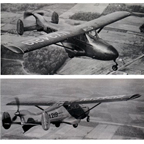
WACO "Aristocraft" Executive Transport
Click to Enlarge
The Waco "Aristocraft" was a high-wing monoplane with the engine in the nose and propeller on the tail. The landing gear is semi-retracting tricycle, and the fuselage sits close to the ground for ease of entry to the four-place cabin.
After a year of engineering, Waco built the prototype, serial number 9850, registered NX-34219. It first flew on December 31, 1946. It was flown more than 40 hours until retirement in June, 1947. The airplane never went into production.

The Waco "Aristocraft"
Design Patent D-155,256
Click to Enlarge
Click Here for more information about the WACO "Aristocraft" .
Republic F-84 "Thunderjet" Fighter
Dating from 1944, the Republic F-84 "Thunderjet" was a fighter-bomber aircraft. Although it entered service in 1947, the Thunderjet was plagued by so many structural and engine problems that a 1948 Air Force review declared it unable to execute any aspect of its intended mission and considered cancelling the program. The aircraft was not considered fully operational until the 1949 F-84D model and the design matured only with the definitive F-84G introduced in 1951. In 1954, the straight-wing Thunderjet was joined by the swept-wing F-84F Thunderstreak fighter and RF-84F Thunderflash photo reconnaissance aircraft.
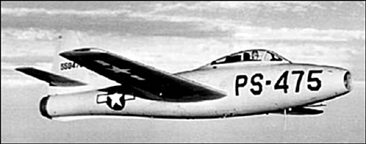
Republic F-84 "Thunderjet"
Click to Enlarge
The Thunderjet became the Air Force's primary strike aircraft during the Korean War, flying 86,408 missions and destroying 60% of all ground targets in the war as well as eight Soviet-built MiG fighters. Over half of the 7,524 F-84s produced served with NATO nations, and it was the first aircraft to fly with the U.S. Air Force Thunderbirds demonstration team. The USAF Strategic Air Command had F-84 Thunderjets in service from 1948 through 1957.



Republic F-84 "Thunderjet"
Design Patent D-153,291
Click to Enlarge
The F-84 was the first production fighter aircraft designed for in-flight refueling and the first fighter capable of carrying a nuclear weapon. Here is a video of the Thunderjet in action:
Click Here for more information about the Republic F-84 "Thunderjet"
North American F-100 "Super Sabre" Fighter
First of the "Century fighters", the prototype F-100 flew on 25 May 1953. The initial production version was the F-100A, a single-seat day fighter. Armament included four 20mm cannon plus external weapons.
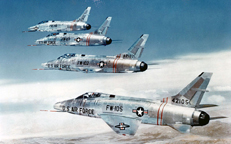

North American F-100 "Super Sabre"
Refueling Three F100s at a time
Click to Enlarge
The F-100C was introduced in 1954 as a single-seat fighter bomber with strengthened wings, up to 7,000 lb of bombs on eight underwing hardpoints along with in-flight refuelling capability. The artwork below shows this underwing capability.
On the Cover of Model Airplane News
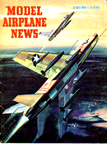
North AmericanF-100 "Super-Sabre"
Model Airplane News Cover for August, 1956
by Jo Kotula
Click to Enlarge
The similar F-100D introduced design refinements, including a taller fin, and could be armed with four Sidewinder or two Bullpup missiles, or 7,000 lb of external weapons in addition to the four 20mm cannon. The final version built was the F-100F, a lengthened tandem two-seat operational trainer and tactical attack aircraft, armed with two 20mm cannon and capable of carrying 6,000 lb of weapons.
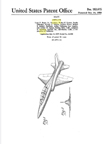

Patent Diagrams for the F-100
Design Patent D-183,675
Click to Enlarge
Click Here to learn how to get free patent diagrams
Click Here for more information about the F-100.
Counter for the Entire Site (not just this page..)
Home | About Lindy | 1940s Collectibles | Upcoming Events | Vintage Clothing
The Guide - Establishments - Travel - Accessories
Music | Links | Photo Gallery | Extras | Contact